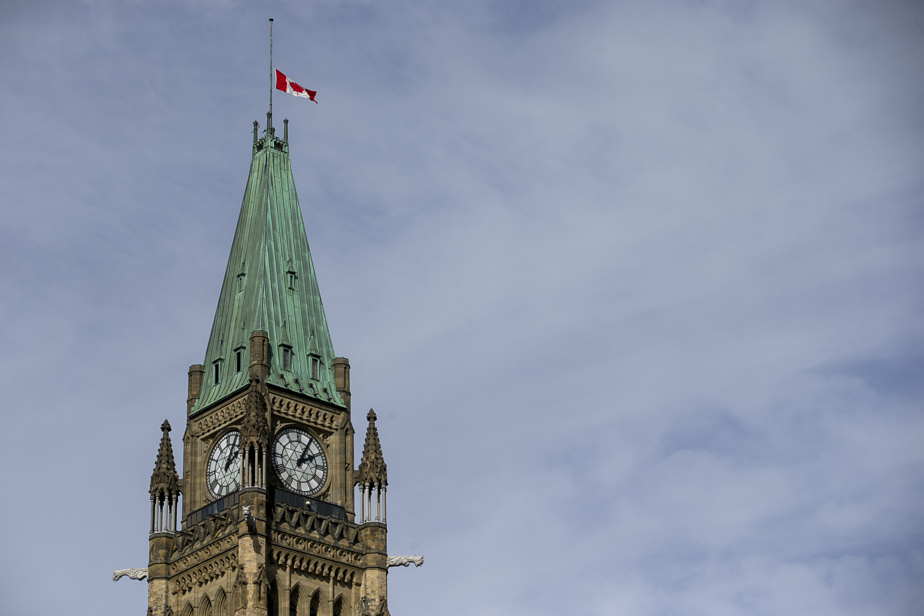(Ottawa) The strength of the recovery in Canada’s economy not only allows for a downward revision of the federal government’s historical deficit since the start of the COVID-19 pandemic, but also points to a possible return to a balanced budget within five years according to forecasts revealed Tuesday by Finance Minister Chrystia Freeland.
After posting a record deficit of $327.7 billion in 2020-2021 — $27 billion less than budgeted in April — the deficit is expected to be $144.5 billion during the current fiscal year, which ends March 31, at $10. 1 billion less than expected eight months ago.
The deficit is expected to reach $58.4 billion in 2022-2023, $43.9 billion in 2023-2024, and $29 billion in 2024-2025. It is then assumed to continue declining in 2025-2026, rising to $22.7 billion and abutting $13 billion in 2026-2027. This deficit could turn into a balanced budget if economic growth is stronger than expected and the federal government sticks to its fiscal framework with discipline.
During this period, the accumulated debt will have more than doubled from $721 billion before the pandemic to $1,358.9 billion in 2026-2027. This financial burden will have dire consequences: Debt fees will double within seven years, jumping from $20.4 billion in 2020-2021 to $40.9 billion in 2026-2027. But according to the Treasury’s calculations, the federal debt as a percentage of the size of the Canadian economy (GDP) would be 44% manageable.
Minister Freeland has been forced to present her economic update in a virtual way to the House of Commons after two of her close aides tested positive for COVID-19.
MI Freeland was particularly happy to see that Canada had regained 106% of the jobs lost at the height of the pandemic. It is an even more impressive result compared to the US, where only 83% of the jobs lost so far have been recovered.
“Canada has largely recovered from the economic damage inflicted by COVID-19 and is poised to experience robust growth in the coming months,” the minister said in her speech.
Although red ink continued to flow into Ottawa, the minister emphasized that the government was managing public finances in a responsible manner.
“We know Canadians work hard for a living and expect us to be careful with their money. It is our duty to do what is necessary, for today and tomorrow,” she said.
“We remain determined to honor the budget pillars we set out in this spring’s budget, to lower the federal debt-to-GDP ratio over the medium term and reduce the deficit associated with COVID-19. […] Our government will continue to play the role of responsible financial manager,” she added.
Since taking office in 2015, liberals Justin Trudeau has never presented a balanced budget. During its first mandate, the Liberal government promised a modest shortfall of about $10 billion annually to make strategic investments and restore budget balance during the last year of that mandate. Instead, the deficits were hovering around $20 billion a year, and the promise of a return to a balanced budget was dashed.
The COVID-19 pandemic has forced the federal government to open doors in an unprecedented way to support families, workers and businesses while essentially shutting down the economy to avoid the worst.
In the economic update, Secretary Freeland also announced $4.5 billion to counteract the effects of the new, more portable Omicron variant, and $5 billion to fund the reconstruction of the District of Columbia. Britain was devastated by the recent floods. MI Freeland also committed $20 billion to compensate Aboriginal children, the court ruling states, and another $20 billion over five years to improve services for children in Aboriginal communities across the country.
According to Robert Aslin, Senior Vice President of the Canadian Business Council and former advisor to former Finance Minister Bill Morneau, the forecasts in Mr.I Freeland does not hold up.
He pointed out that it deleted from its accounts about 78 billion dollars that were the cost of various liberal promises during the last election campaign. It also does not take into account the potential increase in health transfers from the governorates. Finally, it does not take into account the significant costs associated with energy conversion either.
“This government still has a spending problem,” said Aslin, who was also an advisor to Justin Trudeau before he became prime minister. “It’s still spending a lot. Election promises, energy transition costs and the pandemic, it all means that the deficit will not decrease as quickly and that it will be much larger than expected,”
“In my opinion, the long-term outlook is not holding up despite the good news in terms of revenue,” he said, noting in passing that there is already a large structural deficit in Ottawa.
During a briefing, a senior official argued that a return to balanced budgets per se is not a government goal. He said that the level of debt as a percentage of GDP is the main fiscal pillar. “What matters is the composition of the expenditures that are made and whether they contribute to improving the foundations of the Canadian economy,” said the senior official, who was not identified.

“Subtly charming problem solver. Extreme tv enthusiast. Web scholar. Evil beer expert. Music nerd. Food junkie.”


